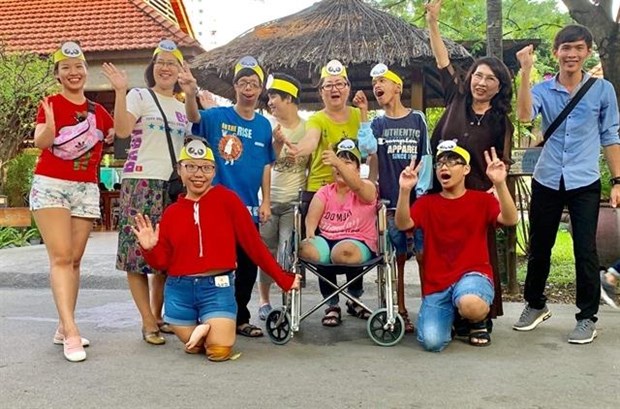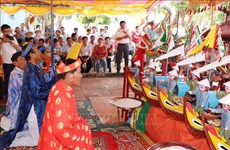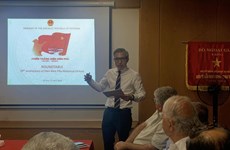Light at end of the tunnel for Agent Orange victims
It was on August 10, 1961, that the US military first sprayed Agent Orange in Vietnam. 58 years have passed, yet the tragic legacy left behind by the toxic defoliant remains indelible.
 Children of Tu Du Hospital's Hoa Binh Village take part in a teambuilding activity (Source: VNA)
Children of Tu Du Hospital's Hoa Binh Village take part in a teambuilding activity (Source: VNA)Hanoi (VNS/VNA) - It was on August 10, 1961, that the US military first sprayed Agent Orange in Vietnam. 58 years have passed, yet the tragic legacy left behind by the toxic defoliant remains indelible.
Every day, some three million Agent Orange and dioxin victims in Vietnam struggle to survive, living their lives with incurable wounds.
At the age of 20, Pham Thi Thu Diem still sits behind her mother on a morning ride to central Da Nang city’s Centre for Agent Orange Victims in Hoa Vang district.
“Diem struggled to learn at school so we let her drop out,” Nguyen Thi Loi, Diem’s mother, told Vietnam News Agency.
“Since an acquaintance introduced us to the centre, we decided to send her here, hoping she will learn to take care of herself,” she added.
After five years at the centre, Diem can write her name and read simple words. She has also demonstrated a special talent for drawing, sewing and making fabric flowers – simple things to many people, yet great achievements for an Agent Orange victim like Diem.
According to Tra Thanh Lanh, deputy head of the Da Nang City Association of Agent Orange/dioxin Victims, more than 5,000 people impacted by the chemical in the city face difficulty every day.
The association has provided several vocational training and life skills courses as a way to help them obtain their independence.
The efforts have brightened up the lives of many victims.
“I want to be a tailor,” said Diem when asked about her aspirations.
On a three-wheeled motorcycle, 39-year-old Dang Trinh Bo roams every corner of Hanoi’s outlying district of Thuong Tin, delivering freshly harvested vegetables to local restaurants.
Wiping sweat from his brow, Bo told Ha Noi Moi (New Hanoi) newspaper that his list of orders seemed endless.
“The job is difficult, but it helps improve the lives of my family,” he said.
Born to parents who were both contaminated with Agent Orange, Bo and his siblings were all impacted by the chemical, suffering intellectual disabilities and mobile impairment.
As the strongest child, Bo set himself a goal of helping his family escape from poverty and earn sustainable livelihoods.
He was offered a vocational training course by a local charity and began a career as an electrician in 2004.
Observing an emerging trend in trading agricultural commodities, he switched careers and now picks vegetables to supply eateries around the district.
The decision has not only improved the lives of Bo’s family but also helped him meet a partner in 2009.
After a decade of hard work, the couple now own a house and run a business which is profitable enough to both take care of their two children and support Bo’s siblings.
The three-wheel motorbike accompanies Bo on his journey to pay it forward, helping other victims in worse conditions.
“The seeds of kindness Bo has sown show that no matter our backgrounds, we can still contribute to the community,” said Chu Thi Phuc, head of the Thuong Tin District Association of Agent Orange/dioxin Victims.
In 1975, Pham Chi returned to Hanoi from a battlefield east of Truong Son range, hoping for a peaceful life after days of violence.
The humble dream, unfortunately, was shattered as his only daughter suffered from intellectual impairment as a consequence of Agent Orange.
The pain motivated Chi to take part in charity work as the head of the Kim Liên Commune Association of Agent Orange/dioxin Victims in Dong Da district with a mission to help others stabilise their lives.
Further assistance
Since 2004, more than 85 billion VND (3.65 million USD) has been allocated by public and social organisations to support families of Agent Orange/dioxin victims in production, housing, education, healthcare and vocational training.
According to Nguyen Sy Thuy, head of the city Association for Agent Orange/dioxin Victims, local authorities have made sure that more than 50,000 people infected with and exposed to the chemical fully receive support and enjoy assistance policies.
In 2016, the first ever centre providing medical support for victims of toxic chemicals including dioxin opened in Yen Bai commune, Ba Vi district.
Thanks to comprehensive treatment and healthcare, some 100 victims have seen improvements, said the centre’s director Tran Dang Khoa.
More than 1,700 km away from Hanoi, in Ho Chi Minh City’s Tu Du Hospital, there is a home for more than 400 children with disabilities caused by Agent Orange/dioxin over the past three decades.
Hoa Binh (Peace) Village is where children have been cared for and taught to stand on their own feet.
According to Nguyen Thi Ngoc Phuong, former director of Tu Du Hospital, the village is the 13th centre that a German non-governmental organisation called Friedensdorf International helped to build in 1990.
From here, many children have grown up, graduated from local universities and colleges then returned to work at Tu Du Hospital and help other Agent Orange/dioxin victims. - VNS/VNA













